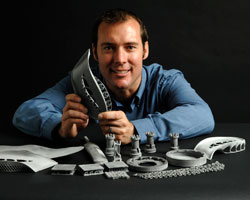Grayscale 3D Printing Can Cut Costs

Professor Neil Hopkinson, inventor of the high-speed sintering additive manufacturing process. Image courtesy of Loughborough University.
Latest News
August 21, 2014
 Professor Neil Hopkinson, inventor of the high-speed sintering additive manufacturing process. Image courtesy of Loughborough University.
Professor Neil Hopkinson, inventor of the high-speed sintering additive manufacturing process. Image courtesy of Loughborough University.We’re always happy to hear about innovations that make 3D printing faster, cheaper or better. Engineers at the University of Sheffield announced earlier this month that they’d come up with a way to accomplish all three of those things for one type of printing process.
Using a high-speed sintering (HSS) technique (which uses plastic powder and special inks), the researchers say they are able to control the density and strength of the final product by printing the heat-sensitive ink in different shades of gray. Doing so, they can produce stronger parts using less ink.
Discover more about the HSS process here.
“All HSS work to date has involved printing 100 percent black, but this doesn’t get the best results,” said Professor of Manufacturing Engineering Neil Hopkinson. “We found that there is a point at which, as the ink levels increase, the mechanical properties start to reduce. This enabled us to identify the ‘sweet spot’ at which you can gain maximum strength with the minimum amount of ink.”
By varying the amount of space between the dots of black ink on the powdered plastic, the researchers were able to increase the mechanical and tensile properties of the resulting part. The researchers can alter the density of material by as much as 40 percent, and potentially produce items with different densities in the same structure. In that way, users could maximize strength while reducing weight.
“3D printing has focused on optimizing the shape of a part in order to reduce its weight and still retain its mechanical properties Hopkinson said. “Printing in grayscale will enable us to optimize the material instead, in a process that would be feasible for commercial manufacture. And by making parts with different densities out of one material, we can also make recycling more straightforward.”
Hopkinson presented the findings at the 25th International Solid Freeform Fabrication Symposium at the University of Texas at Austin this month.
Source: University of Sheffield
Subscribe to our FREE magazine, FREE email newsletters or both!
Latest News
About the Author
Brian Albright is the editorial director of Digital Engineering. Contact him at [email protected].
Follow DE





